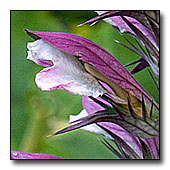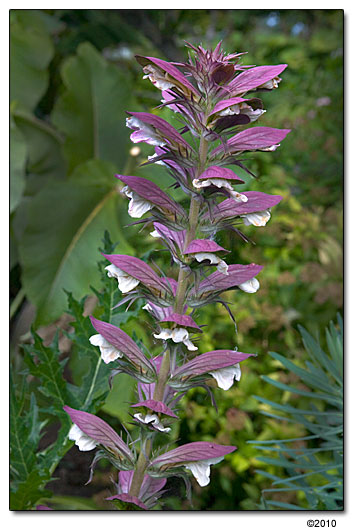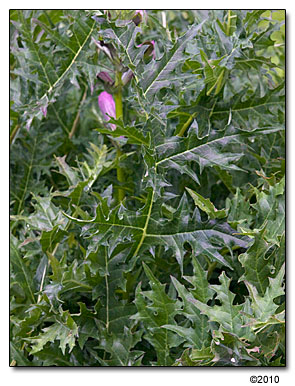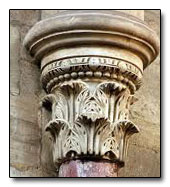Acanthus spinosus
SPINY BEAR'S BREECHES, SPINE ACANTHUS, OYSTER PLANT
Family: Acanthaceae
Pronounced: ah-KAN-thus speen-OH-sus

Quick Jumps
Growing Guide
Rainy Side Notes
GROWING GUIDE

Geographical origin:
Southeastern Europe, eastern Mediterranean areas, northeastern Italy and western Turkey.
Plant Group:
Perennial.
Hardiness:
Sunset zones: 4-24.
USDA zones: 6-9, possibly as low as 5.
Heat zones: 9-5.
Mature size:
Height: 3 feet (90 cm).
Width: 4 feet (1.2 m).
Flowering period:
Late spring to midsummer.
Flowering attributes:
White flowers, sometimes with shades of pink, surrounded by purple calyces on two-foot tall spikes.
Leaf attributes:
Deep green, deeply lobed, 12-inch long leaves with soft spiny margins. Evergreen in warmer USDA zones of 7 and up.
Growth habit:
Clump-forming.
Light:
Full sun or partial shade but prefers morning sun and afternoon shade.
Soil:
Humus rich, moist, well-drained soil.
Feeding:
Side dress with compost or manure. Fertilize in spring with a complete organic fertilizer.
Propagation Methods:
Sow seed in spring and place in a cold frame or in situ as soon as seed is ripe. Germinates in 3 — 4 weeks at 50°F (10°C). | Divide in spring or fall. | Root cuttings in early spring.
Rainy Side Notes

The Priest of Beauty, the Anointed One,
Through the wide world passes the Poet on.
All that is noble by his word is crown'd,
But on his brow th' Acanthus wreath is bound.
Eternal temples rise beneath his hand,
While his own griefs are written in the sand;
He plants the blooming gardens, trails the vine—
But others wear the flowers, drink the wine;
He plunges in the depths of life to seek
Rich joys for other hearts—his own may break.
Like the poor diver beneath Indian skies,
He flings the pearl upon the shore—and dies;
—Speranza (Jane Francesca Wilde)

Although spines are the norm for this plant, they are too soft to harm those that touch them. One of my sources says they are vicious plants, but I'm thinking they meant the species A. spinosus var. spinosissimus, which has wicked ways with wicked spines.
Acanthus comes from the Greek word acanthos, meaning thorn. It's easy to figure out what its epithet spinosus means and you are correct if you thought spines.
The common name, bear's breeches, is somewhat puzzling; however, it was originally derived from brank-ursine, a Latin word for bear's claw. It appears that time and translations might have something to do with how it ended up as breeches instead of claw.
In 1629, an English herbalist, John Parkinson, called an acanthus a thistle in his writings. "This prickly thistle hath divers long greenish leaves lying on the ground..."

Callimachos, fifth century Athens sculptor and architect, is credited for using an acanthus leaf as a design for Corinthian column capitals. The leaf design is still used today as a design element. It's no wonder that the in the Victorian language of flowers acanthus signified artistic skills and fine arts.
This is a bold, spectacular plant and not for those who want a dainty look. Planting its tropical form in with hostas and ferns makes a grand statement in the shade garden.
Photographed in author's garden.

Gardening for the Homebrewer: Grow and Process Plants for Making Beer, Wine, Gruit, Cider, Perry, and More
By co-authors Debbie Teashon (Rainy Side Gardeners) and Wendy Tweton
Copyright Notice | Home | Search | Perennials

